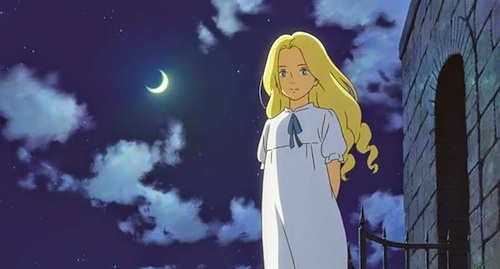By Joe Bendel. For young Anna Sasaki, coming of age is a particularly dramatic process, in a dark psychological kind of way. She is like a character out of Daphne du Maurier or Mary Roberts Rinehart novels, who has been sent to spend the summer in a bucolic marshland that could have been painted by the Impressionists. Nobody would be better suited to realize her new environment than the Studio Ghibli team, but alas, this will be their final release for the foreseeable future. While it lacks the tragic sweep of its immediate predecessors (Princess Kaguya and The Wind Rises), Hiromasa Yonebayashi’s When Marnie Was There is an appropriately intimate goodbye that packed the house for the opening night of the 2015 New York International Children’s Film Festival.
Sasaki is far too sensitive to make friends easily with her classmates. Her stress-aggravated asthma does not help, either. After a particularly severe attack, Sasaki’s mother Yoriko sends her to stay with her extended relatives, kindly old Kiyomasa and Setsu Oiwa. However, as a foster child, Sasaki has difficulty accepting any of them as family, including Yoriko, despite their genuine concern.
To humor Setsu, she makes a few half-hearted efforts to befriend some of the village girls her age, but Sasaki prefers to make sketches on her own. One of her favorite subjects is Marsh House, an abandoned mansion only intermittently accessible during low tides. Strangely though, a young girl named Marnie seems to live there with her ominously gothic servants. Sasaki and Marnie are drawn to each other like lonely kindred spirits. At last, each feels they have finally found a true friend. Yet, Marnie’s penchant for vanishing without a trace confuses and sometimes hurts Sasaki.

It does not take much deduction or intuition to figure WMWT is some sort of supernatural story, but it still holds some profoundly resonant secrets. It certainly looks like a Studio Ghibli film, which means it is lushly gorgeous. As with The Secret World of Arrietty, his previous film as a director (also based on a British YA novel), Yonebayashi fully captures the beauty and malevolent power of the natural world. Frankly, it is rather impressive how quickly and yet how smoothly he can change the vibe from sunny pastoral to psychological suspense. There is even a scene in a supposedly haunted grain silo that evokes the mission tower staircase in Vertigo, fittingly enough in a film featuring a titular character named Marnie.
WMWT is a deeply humanist film, brimming with forgiveness and empathy. Through her POV, we will acutely understand how coming to terms with the past will allow Sasaki to carry on and embrace life. As a potential sign-off from Studio Ghibli, that’s not bad. Amongst their storied output, it probably ranks somewhere in the middle, but had it come from just about any other animation house, it would represent their crowning achievement. Granted, the opening act is a little slow getting it in gear, but overall, it is remarkably astute emotionally and refreshingly life-affirming. Highly recommended, When Marnie Was There screens again next Saturday (3/7) at the SVA Theatre, as part of this year’s NYICFF.
LFM GRADE: A-
Posted on March 4th, 2015 at 10:12pm.